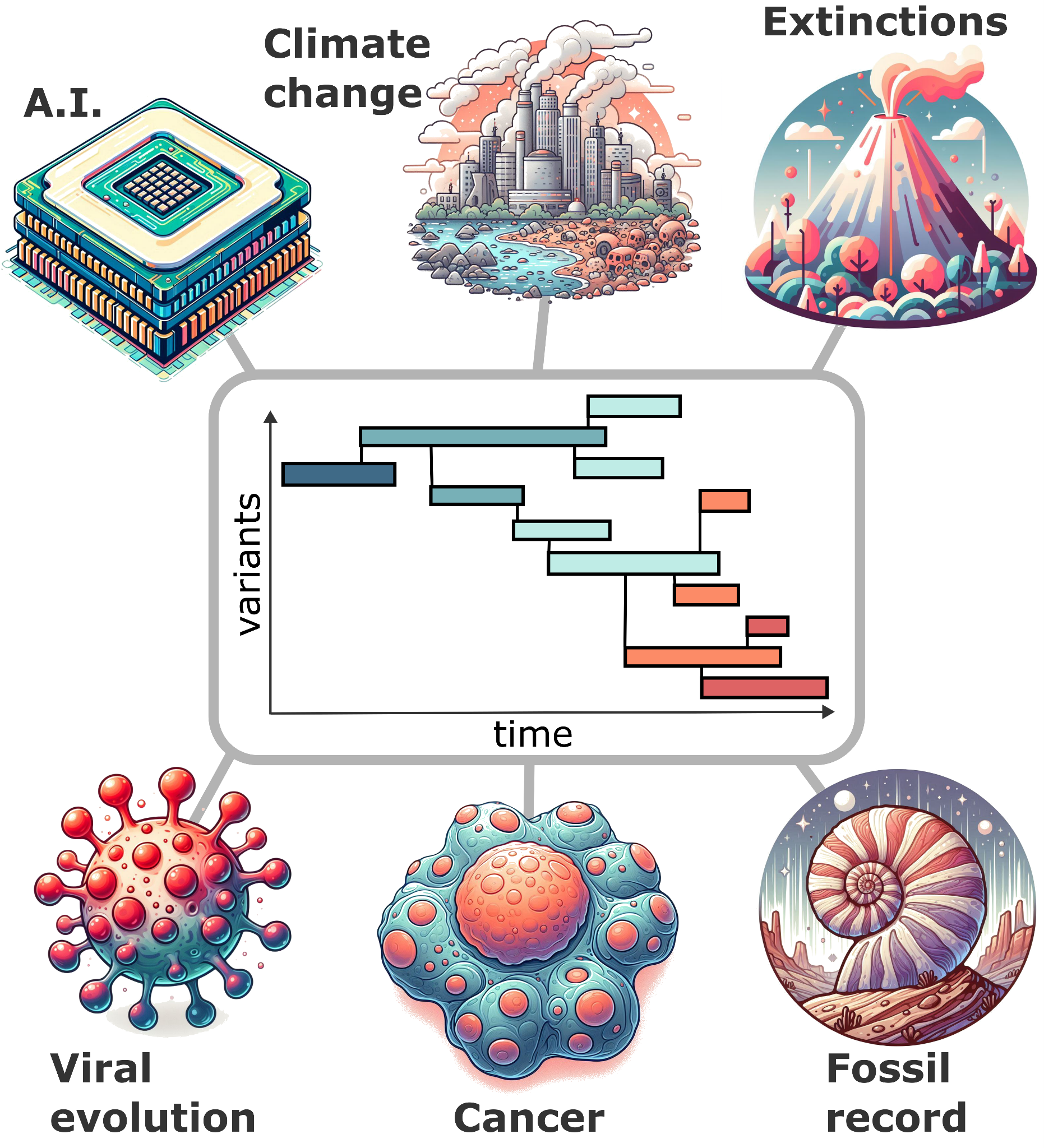Punctuated Evolution: Understanding Sudden Shifts in Nature and Society
The team of Evolution of Networks Lab at the IBE walks us through the major historical changes with a new evolutionary lens that sheds light on the dynamics of molecular biology, anthropology, and social and technological systems: the theory of Punctuated Evolution.

Approximately 251.9 million years ago, a massive volcanic explosion nearly wiped out all life on Earth. Known as the Permian Extinction, this punctuated event radically changed life and the ecosystems that existed for a long time. Along with this wave of devastation came innovation, and the massive extinction triggered the emergence of many never-before-seen lifeforms. Such catastrophic occurrences are not exclusive to prehistoric times; they continue to influence our world today, although many of them are now our fault.
Punctuated evolution accounts for the many causes behind the sudden rise and fall of species, cultures and technologies. From volcanoes to climate change, punctuated evolution takes place when long periods of stability are interspersed by rapid changes that shape our world.
The new theory, which takes inspiration from the punctuated equilibria theory that paleobiologists first proposed 50 years ago, has provided a framework for understanding abrupt species changes in the fossil record. However, punctuated evolution not only helps to explain the fossil record but also illuminates the dynamics of molecular biology, anthropology, and even social and technological systems. Could the bursts of innovation that define human history and modern technology be another form of this ancient evolutionary dance?
Biological Bursts: Evolution in the Life Sciences
Research in punctuated evolution over the last 50 years has shown that evolution often happens in sudden leaps rather than through gradual changes. We can clearly see this pattern in the rapid evolution of carcinomas, where major genetic shifts create new cell lineages. The COVID-19 pandemic has starkly illustrated this pattern, showing how viruses can quickly adapt in response to external pressures, creating ongoing public health challenges. These examples highlight the importance of recognizing punctuated evolution in understanding disease dynamics and crafting effective interventions.
Human Creativity: Rapid Advances in Anthropology
Anthropology offers striking examples of punctuated evolution. Around 45,000 years ago, during what is known as the "Upper Paleolithic Transition," human creativity and technology seemed to have surged ahead rapidly. In a sharp break from millennia of slow progress, our ancestors suddenly began developing advanced tools, creating intricate art, and forming complex social structures. This burst of innovation underscores how human societies can swiftly transform in response to environmental and social pressures, reflecting the same patterns of sudden change seen throughout evolution.
Technological Revolutions: From the Industrial Age to AI
Technological evolution often follows a pattern of sudden leaps rather than steady progress. Look at the Industrial Revolution or the Digital Age—both brought rapid, transformative changes. Today, we're witnessing this again with artificial intelligence. For years, AI has advanced slowly, but the arrival of large language models has sparked an explosion of new capabilities, transforming industries and daily life almost overnight. Punctuated evolution in technology suggests that innovations might come in sudden, dramatic bursts, reshaping our world in ways we can't yet predict.
Climate Change and Marine Ecosystems: Lessons from the Past
The Permian mass extinction, which occurred approximately 250 million years ago, serves as a prime example of punctuated evolution in geology. This event, which was the result of volcanic activity in the Siberian Traps, caused the extinction of 95% of existing species. The massive release of carbon dioxide led to drastic climate shifts, exemplifying how punctuated evolution can operate on a planetary scale. Rapid releases of carbon dioxide, both past and present, drive evolution. Overwhelming oceans, atmospheric dust, and ocean currents cause rapid reactions, leading to rapid global warming and acidic oceans, endangering marine ecosystems and biodiversity.
A Call to Action: overcoming planetary challenges through an evolutionary lens
When there is a large release of carbon into the atmosphere, as is happening with climate change, it can lead to a quick burst of novel species after many have died out. This punctuated event, which has happened in the past, is likely to repeat again due to our own actions, posing a serious danger to the survival of many species. However, unlike other species, we have the ability to see changes coming and respond. By recognising the similar pattern of punctuated evolution in the past and today, we can help lessen the effects of climate change and maintain the delicate balance of life on Earth.
Punctuated evolution is not merely a relic of the past; it continues to shape our world. Whether addressing climate change, conserving biodiversity, or navigating technological shifts, understanding punctuated evolution gives us a powerful framework for action. By viewing climate change through an evolutionary lens, society can better prepare for and influence the future of the planet and its inhabitants.
Referenced Article
Duran-Nebreda, S., Bentley, R. A., Vidiella, B., Spiridonov, A., Eldredge, N., O’Brien, M. J., & Valverde, S. (2024). On the multiscale dynamics of punctuated evolution. Trends in Ecology & Evolution. DOI: https://doi.org/10.1016/j.tree.2024.05.003
